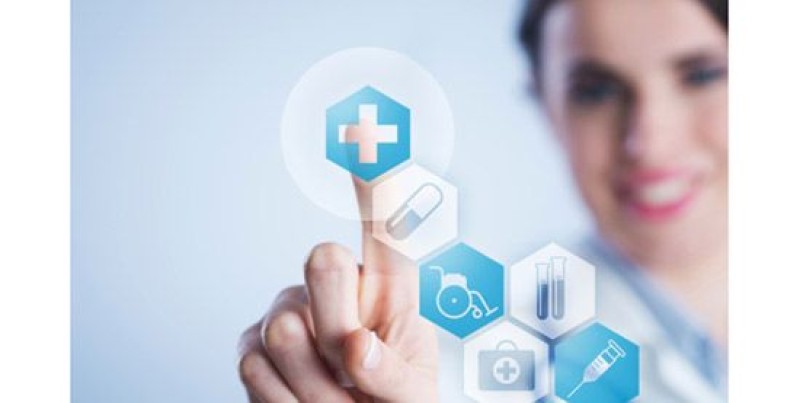Healthcare, at its core, is a very intimate and personal industry. Individuals often develop long-term, trust-based relationships with their doctors, pharmacists, and other healthcare stakeholders. They strive for that level of personalization and intimacy in all aspects of their healthcare experience. Today we are truly at the intersection of humanity and technology in healthcare, where new ideas and innovations to improve people’s lives and health experiences are being enabled by technology and strategy.
Jeffrey Bauer, Ph.D., an independent health futurist and medical economist, says that “technology is providing [the world] with an unprecedented opportunity” to develop good healthcare systems. From bionic limbs to extremely targeted treatments and forecasts of individuals’ risks for various diseases, healthcare as we know it today is only possible due to vast advances in technology that is changing patients’ lives. “We have the opportunity to create phenomenally better healthcare systems in terms of delivery, outcomes, and reducing costs,” he says.
While the most talked-about advances tend to relate to medical interventions, technology is also working hard behind the scenes to improve patients’ experiences. Pat McCaffrey, TeleTech’s senior vice president for healthcare and government solutions, says that the industry is being transformed through tools and technologies that seamlessly leverage data, personalize member outreach and engagement, and improve provider collaboration for better outcomes. In the doctor’s office, at the pharmacy, and on the phone to the contact center, innovative companies are looking outside-in to improve how patients and customers interact.
Patient journey transformation
There are too many innovations happening to list here, but we have identified a few notable areas of the patient journey that are being influenced by a customer-focused approach.
Proactive prevention
Data identifies early risks: The adage “prevention is better than cure” has a lot of truth to it. Patients and their families benefit greatly when a health issue is preempted and addressed before it becomes a problem.
The predictive element of data is being used by healthcare institutions to help them save lives. The Hospital for Sick Children in Toronto uses data to identify the risk of infections in preterm babies before they are visible to clinicians. In collaboration with the University of Ontario Institute of Technology, Project Artemis was developed to leverage the huge amounts of data collected by equipment monitoring babies’ vital signs to determine when a child is at risk of infection. Andrew James, associate clinical director of the hospital’s neonatal intensive care unit, said in an article that the data showed telltale signs of heart rate changes in babies who subsequently developed an infection. Today, doctors have the tools to identify the early warning signs of an infection up to 24 hours before any other symptoms would have raised the alarm, leading to earlier treatment and less suffering for the tiny infants and their parents.
Health plans can also leverage data to be more predictive and proactive in outreach to at-risk members. Big Data initiatives may uncover potential risks in certain members based on the analysis of aggregated behavior, demographic, and claim data. Payers can then offer preventative information or act in an advisory way before something gets too serious.
Virtual queues reduce wait times: There is little doubt that waiting to be seen by a doctor is one of the most frustrating parts of accessing healthcare, especially when the individual is sick. Aware of this, Linda Ratner, executive director at Texas’ Impact Urgent Care, sought to find a way to reduce waiting times at the health provider’s two urgent care facilities. In April 2013, the two clinics began offering virtual queues, where patients line up ahead of time from their phones or online. Patients are told how many other people are ahead of them and are given an estimate of when they can see a doctor, saving them from long stretches in the waiting room. Ratner says that even during peak months, patients only have to wait for a few minutes before they are seen by a doctor, translating into a 20 percent improvement in patient satisfaction.
Getting ahead of illness: In May 2013 actress Angelina Jolie revealed in a candid op-ed in the New York Times that she had undergone a preventative double mastectomy after finding out she carried the BRCA1 gene, which exponentially increases her risk of breast and ovarian cancers.
Jolie’s experience shone a spotlight on genetic testing, now being used to identify individual risks and develop tailored treatments. “Technology is allowing us to determine which treatment makes the most sense for an individual patient,” Bauer says. Selecting the right treatment obviously has an impact on the patient, and also helps to improve the ROI of medicine by spending money on the most appropriate interventions, as early as possible, that are expected to have the best results.
Personalization empowers patients
Telemedicine brings patients and doctors together: According to the American Telemedicine Association, more than half of the hospitals in the United States use some form of telemedicine. Close to 1 million Americans use remote cardiac monitors and millions of patients worldwide use telemedicine to monitor their vital signs and reduce the need for hospital visits.
Mobile technology is also making it possible to virtually connect to a doctor anytime and anywhere. Bauer says that this helps reduce the costs of commuting and decreases the risk of sick patients spreading contagious diseases in waiting rooms. With mobile devices, patients can share very clear images or video of problems they might be having with their physicians. “Smartphone pictures are of diagnostic quality,” he says. Additionally, telemedicine could be potentially life-saving, not to mention extremely convenient, for patients who live hours away from the nearest hospital and require immediate help. It may also spur more preventative doctor interactions.
Real-time personalized content in the hospital room: A new diagnosis can be a shock for patients and their families. And searching online for accurate additional information can be a rabbit hole. Knowing this, the Carolinas Healthcare System invested in interactive patient technology for nearly all patient rooms in two hospitals. Dianne Novak, vice president of patient experience, explains that informative videos are made available to patients on bedside televisions, empowering them to learn more about their care immediately.
Content is ordered in accordance with an individual patient’s needs. For example, a patient who has just been diagnosed with heart failure will get information about his condition and medication that he has been prescribed, allowing both the patient and his family to learn more and ask questions while still at the hospital with access to medical staff.
The system also asks patients questions about various aspects of their in-patient experience, ranging from dietary needs to pain management. This allows the hospital to make any changes while the patient is still receiving treatment. Novak says more than 90 percent of patients are using the technology and surveys have shown a 50 percent improvement in both hospitals’ performances since they started using the technology.
Social media and patient networks: Some institutions are leveraging social methods to improve collaboration and communication, both between doctors and patients as well as among patients themselves. The Mayo Clinic is among the most advanced healthcare institutions when it comes to leveraging social media and in 2010 launched its Center for Social Media, which serves as a resource for health-related organizations that are interested in leveraging social tools.
Bauer also notes that social channels are providing wonderful opportunities for patients to talk to others going through similar experiences, acting as both a source for non-medical research as well as support networks. There are dozens of patient networks, including Patients Like Me, where patients share details about their medical conditions and compare and contrast different diagnoses and treatments. An added bonus is the ability to identify side effects from particular drugs or other similarities between patients which would otherwise have taken many years to spot, Bauer says.
It is heartening to see both clinicians and insurers leverage new technologies to improve their areas of the patient journey. The healthcare industry is being presented with an unprecedented opportunity, Bauer says, and needs to continue making the most out of it.
McCaffrey adds that more personal approach to data in the healthcare space is also an area of enormous opportunity. “For instance, by making the on-boarding process more welcoming and engaging, a health plan can often gather information about a member’s particular health challenges and in the process tailor the information they receive to enable the member to live a healthier life.”
To continue on the path of healthcare transformation, payers and healthcare providers need to embrace technology and redesign processes. “To succeed and differentiate in the healthcare market of the future, stakeholders must leverage technology,” McCaffrey stresses, and not be afraid to try new tools and nontraditional interactions that improve the patient experience. This includes using cutting-edge technology to build multichannel communication strategies that are customized to members and patients. “Those stakeholders who are successful in this regard will command mindshare with their member and patient population and build lasting ties with them.”















